Mastering Kitesurfing: Essential Techniques and Tips
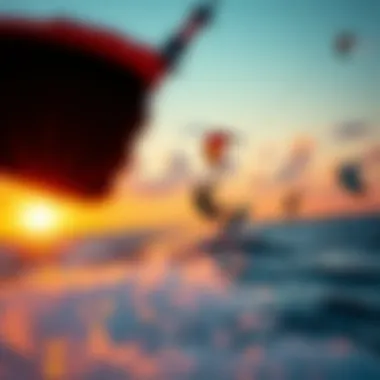

Intro
Kitesurfing has grown in popularity over the years, transforming from a niche sport to a global phenomenon. With its gripping blend of surfing, wind, and adrenaline, it draws adventurers eager to ride the waves powered by nothing but the wind and their skills. This guide aims to serve both the novice looking to dip their toes into this refreshing world and seasoned kiteboarders seeking to refine their craft. By delving into the nuts and bolts of kitesurfing, from equipment essentials to refining techniques, we hope to provide meaningful insights to elevate your kitesurfing experience.
What You’ll Learn
From the moment you decide to embark on this thrilling journey, understanding what you need and how to navigate the waves becomes paramount.
- Selecting the right equipment can make or break your experience.
- Safety is not a suggestion; it's a necessity.
- Techniques vary greatly between beginners and advanced riders, and there's always something more to learn.
- Diving into the ever-evolving technology keeping you on top of those waves.
- Finding those hidden gems worldwide where the winds blow just right and the waters are as inviting as they come.
This guide is designed to be a one-stop-shop for all things kitesurfing, stirring a passion for the sport and landing you on the right path to mastering this art. Whether you’re eyeing a tranquil beach in Tarifa or the gusty winds of Maui, with proper knowledge and the right mindset, you can conquer the complexities of kitesurfing.
With that said, let’s break it down, starting with the heart of any kitesurfing adventure: the equipment.
Prelude to Kitesurfing
Kitesurfing has grown from a niche sport into a global phenomenon, captivating wave riders and thrill-seekers alike. The introduction to kitesurfing plays a crucial role in any aspiring rider's journey, as this segment lays the foundation for understanding not only how to operate the kite and board but also what this sport embodies in terms of adventure and community.
Understanding Kitesurfing
At its core, kitesurfing merges the elements of wind, water, and the rider's spirit. When one talks about kitesurfing, it’s more than just the act of riding. It’s a dance with nature, utilizing the wind's energy to glide seamlessly over water. Understanding kitesurfing means grasping the intricate relationship between the kite and the water surface. Each movement on the board is a conversation with the wind, whether it’s gently tugging at the lines or powering the kite for a jump.
The basics of kitesurfing involve controlling the kite while maintaining balance on the board. It begins with understanding how to launch and land a kite, navigating through various winds, and recognizing the importance of body positioning. For beginners, familiarizing oneself with these elements can be overwhelming, yet it sets the stage for a thrilling journey in the waves.
The Appeal of Kitesurfing
So, why does kitesurfing hold such allure? For many, the appeal lies in its blend of adrenaline, skill, and beauty. Imagine carving through pristine waters with the horizon stretching endlessly ahead, the wind in your hair, and the sun on your face. Kitesurfing is as much about the experience as it is about the technique.
Moreover, this sport fosters a vibrant community. Riders, from all walks of life, unite on beaches around the world, forming bonds that can weather any storm. Whether you’re sharing tips at your local spot or competing in an international competition, the spirit of kitesurfing is found in camaraderie and shared experiences—making it both a solitary and communal journey.
Choosing the Right Equipment
In the world of kitesurfing, picking the right equipment is akin to a painter selecting the perfect brush. It’s not just about what looks good; it’s about functionality, suitability, and personal preference. The right gear can make or break your experience on the water, whether you are carving through waves or tackling a stiff breeze. Before you head out, it’s essential to understand not just the types of equipment available, but how they cater to your individual needs, skill level, and the conditions you plan to ride in.
Kites: Types and Specifications
When considering kites, the type you choose significantly impacts your performance and enjoyment. There are mainly two types of kites: C-kites and bow kites. C-kites are favored by those who crave freestyle maneuvers due to their responsive nature. On the flip side, bow kites offer more stability and ease of use, making them a frequent pick for beginners and those riding in variable conditions.
Secondly, the size of your kite matters just as much as its type. Kites typically range from 5 to 17 square meters. The rule of thumb is to match the kite size to the wind conditions: lighter winds require larger kites, while strong winds necessitate smaller options. Proper sizing not only enhances your fun but also safeguards your safety when venturing into challenging conditions.
"Choosing the right kite isn't just about preference; it’s about understanding your environment and how you want to ride."
Boards: Selecting Your Ride
Kiteboards come in several shapes and sizes – different boards are designed for different styles. For instance, you’ll find twin-tip boards, directional boards, and even models designed specifically for freestyle or wave riding. A twin-tip board, which is symmetrical at both ends, is generally the best choice for beginners as it allows easy navigation regardless of the direction you’re riding.
When picking a board, its construction material can affect performance. The most common materials include wood, carbon fiber, and foam, each offering varying levels of durability, weight, and stiffness. As a general guideline, wood boards are often more forgiving, while carbon fiber boards offer responsiveness and lightness - perfect for experienced kiteboarders looking to push their limits. Also, don’t overlook compatibility with your kite. Ensuring your kite and board pair well creates a more harmonious experience.
Harnesses: Support and Comfort
A harness is often overlooked but plays a crucial role in kitesurfing. It’s the way you connect with your kite, making comfort and fit essential. The main types of harnesses are waist harnesses and seat harnesses. Waist harnesses are popular for those who enjoy freestyle tricks, as they provide ease of movement. However, a seat harness, sitting lower on the body, can offer more support when riding in stronger winds.
Fit is critical: a harness that is too loose will shift during rides, leading to discomfort and distraction. On the flip side, a harness that is too tight can restrict movement. Finding the right balance—solid support without compromise on flexibility—is key. Adjustable straps and padded backs can make a significant difference in long sessions. Never underestimate the power of comfort, as a well-fitted harness allows for longer rides and more enjoyment on the water.
In summary, the right kitesurfing equipment involves evaluating multiple facets—types, sizes, and personal preferences. Investing time into selecting the appropriate kite, board, and harness will not only enhance your performance but keep you safe while you chase the wind.
Safety Protocols in Kitesurfing
Kitesurfing is an exhilarating sport, yet it carries its own set of risks. That’s why safety protocols are not just recommendations; they are essential to ensuring enjoyable and safe experiences on the water. Adhering to these safety measures can help prevent accidents, injuries, and catastrophic mishaps that could derail your adventure. When it comes to kitesurfing, preparation can mean the difference between a thrilling session and a trip to the hospital.
Understanding Weather Conditions
Before setting sail, you need to grasp the local weather patterns. Weather conditions can change on a dime, and what looks calm and perfect from the shore might quickly shift into treacherous waves. The wind speed and direction play a crucial role—ideal conditions usually fall between 10 to 25 knots. Knowing the signs of bad weather is key; for instance, dark clouds gathering on the horizon or dramatic shifts in wind can be big red flags.
- Wind: Check if it’s gusty; consistency is paramount.
- Tides: Be mindful of how tides can affect your ride. Low tide might expose underwater hazards, while high tide could bring stronger currents.
- Water Conditions: Look out for white caps, which indicate rough waters and higher wind speeds.
Remember that a grounded kitesurfer is a wise kitesurfer. As they say, "The wind waits for no one."
Essential Safety Gear
Having the right safety gear is non-negotiable; it’s your second line of defense against the unpredictability of the elements. Here’s what you should gear up with:
- Helmet: This protects your noggin from falls or impact with stray equipment.
- Impact Vest: Provides buoyancy and protects your torso from choppy water.
- Life Jacket: While not always required, a life jacket can save your life, especially in unfamiliar waters.
- Safety Leash: This attaches your kite to you, ensuring it doesn't float away if you crash.
- Knife: A small cutting tool to free yourself if you become tangled in your lines.
- Communication Device: A waterproof phone or radio can be lifelines, especially in emergencies.
Equipping yourself with safety gear is one thing, but using it responsibly multiplies your chances of staying safe.
Emergency Procedures
Understanding what to do in an emergency can be a game-changer. When the unexpected happens, the last thing you want is to freeze up like a deer in headlights. Here are some basic but crucial procedures:
- Signal for Help: If you’re in distress, signal your fellow kitesurfers and look for help onshore.
- Manage Your Kite: If you crash, downwind, try to keep the kite low to prevent it from dragging you or anyone else.
- Plan Your Escape: If stuck in strong currents, align yourself pointing downstream and ride it out to calmer waters.
- Check for Injuries: After any fall, assess yourself for any injuries before attempting to reengage.
- Practice Regularly: Regularly practicing emergency procedures makes it easier when the real deal comes around.
"The best way to prepare for stormy seas is to practice your drills when the sun is shining."
Following these safety protocols will make your kitesurfing experience not only safer but also more enjoyable. Be informed, be prepared, and ride with care.
The Learning Curve
Kitesurfing is not merely about riding the wind and water; it’s an experience that involves a steep learning curve. Acknowledging the learning curve is crucial for anyone looking to master this exhilarating sport. It encompasses not only the physical aspects but also the mental adjustments required along the way. Comprehending the learning process helps riders set realistic goals, fostering a sense of achievement and reducing frustration.
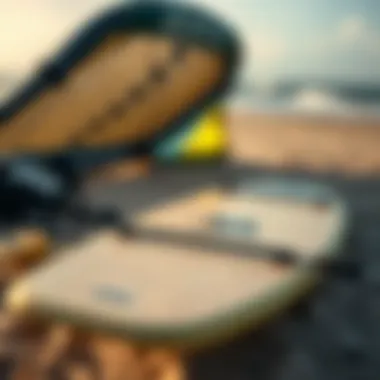
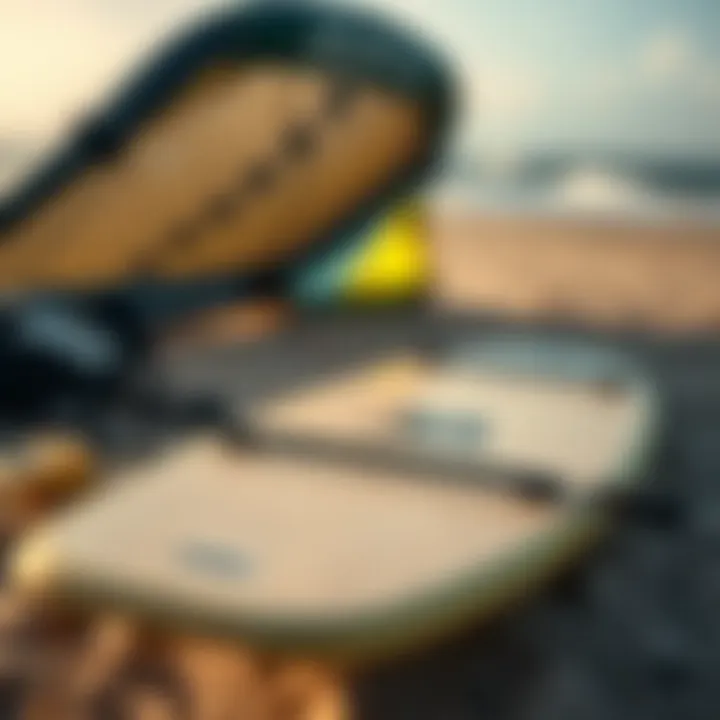
Finding a Qualified Instructor
The first step on the road to becoming a proficient kitesurfer is finding a qualified instructor. Many individuals may feel lost and overwhelmed when faced with the plethora of choices available. However, choosing an instructor with proper credentials, like those certified by the International Kiteboarding Organization, can make a world of difference.
A good instructor does more than just teach; they should create a safe and frustration-free environment for newcomers. Look for reviews from previous students or ask to see proof of their experience. What’s more, the instructor’s ability to adapt to your learning style is critical. Some folks might get it right away, while others might take their sweet time. A skilled instructor will notice those differences and adjust accordingly.
"The best way to learn is under the guidance of someone who’s been where you are and knows the ropes."
First Lessons: What to Expect
Those first lessons can feel like stepping into uncharted territory. Generally, the objective is to get comfortable with the kite and understanding how it interacts with the wind. Expect to spend time on the beach learning safety protocols, kite setup, and basic flying maneuvers. New riders will learn how to manage the lines and harnesses before even gliding on the water.
Instructors might start with land-based lessons to build familiarity with the equipment. You’ll also learn the mechanics of how to keep the kite stable, which is fundamental in preventing mishaps. While it may seem tedious, this foundational knowledge will pay off when it’s time to hit the waves.
Progressing from Beginner to Intermediate
As skill sets improve, progression is inevitable. Gaining confidence on the water takes time, and understanding the balance between power and control is essential. Don’t rush the progress; take the time to refine skills like navigating, turning, and jumping. This phase often involves many small victories—perfecting a maneuver here, mastering a wind curve there.
To solidify the transition, embrace consistent practice and occasional refresher lessons. Engaging with fellow kiteboarders in your community can also provide crucial support and exchange of tips.
In essence, the journey from a beginner to an intermediate rider encapsulates more than just mastering techniques; it's about developing a deeper understanding of the sport, which inherently builds confidence and enhances safety.
The learning curve in kitesurfing is undeniably steep, yet it's through this journey that the most rewarding moments unfold. The thrill of catching the wind and riding the waves is worth every bit of effort spent mastering the art of kitesurfing.
Techniques for Successful Kitesurfing
When it comes to kitesurfing, mastering techniques is as essential as having the right gear. Techniques do not just determine how well you maneuver through the waves; they also influence your safety and overall enjoyment of the sport. Learning the ropes of kitesurfing techniques equips enthusiasts with not only practical skills but also the confidence to tackle varying conditions in a controlled manner.
Basic Maneuvers
Understanding the basic maneuvers is like laying down the foundation of a house; without it, nothing will stand strong. These foundational skills are vital for beginners and contribute significantly to progressing within the sport. A few core basic maneuvers include:
- Launching and Landing: Knowing how to launch your kite correctly assures that you start safely. Checking the wind direction, setting your body stance, and communicating with your assistant are key.
- Body Dragging: This technique is essential when you fall, allowing you to reposition without relying on your board. Keeping your body slightly arched and pulling your arms in creates a streamlined effect, making it easier to recover.
- Riding Upwind: This skill is paramount. To ride effectively, orient your board at a 45-degree angle against the wind. This keeps you from being pushed downwind.
- Turning: Learning how to perform simple turns, like heel-side and toe-side, gives you the control needed to navigate diverse water conditions. Focus on shifting your weight and using your kite's power to facilitate the turn.
Practicing these maneuvers repeatedly builds muscle memory, a crucial aspect of becoming proficient in kitesurfing. Additionally, it's wise to have a refresher on them every time you hit the water.
Advanced Techniques
Once you've got the basics down, it's time to step up your game. Advanced techniques will not only make you a more skilled kitesurfer, but they also enhance your overall experience on the water. Here, we explore several advanced methods:
- Jumping: This is where the thrill kicks in. Utilizing the kite's power, you can launch off the water. The key is to maintain a steady tension in the lines during take-off and to ensure a soft landing by bending your knees.
- Transitions: This involves shifting from heel-side to toe-side without stopping. A smooth transition is both stylish and practical as it keeps your speed up and minimizes interruptions.
- Kiteloops: Kiteloops are not for the faint-hearted. Initiate by pulling hard on the back handle of the kite while shifting your weight. The loop creates a powerful pull, sending you higher into the air.
- Handle Passes: This trick showcases technical skill and looks impressive. To perform a handle pass, you need to release the bar while in the air, passing it behind your back before grabbing it again as you come down.
Mastering these advanced techniques can take time and dedication, but the payoff is huge. They give you the freedom to express yourself on the water and tackle a wider range of environments and conditions.
"The only way to get better at kitesurfing is to keep pushing your limits, be it through consistently hitting the water or studying techniques tirelessly."
Embracing both the basic and advanced maneuvers will propel your kitesurfing journey forward. Remember to practice safe riding and stay aware of your surroundings whenever you’re out on the water.
Exploring Kitesurfing Locations
Kitesurfing is much more than just a sport; it's an experience that intertwines thrill, connection to nature, and a sense of community. One of the critical aspects of enhancing your kitesurfing journey is the location. Exploring kitesurfing locations can make or break your time on the water. Not only do different spots offer unique challenges, but they also present distinct opportunities for both novice and seasoned kiteboarders.
The choice of location affects your overall skills and enjoyment; it can encourage or hinder your progress. Factors such as wind consistency, water conditions, and local regulations play significant roles in determining the right spot for your session. Additionally, understanding different environments enables riders to adapt their techniques accordingly, fostering both safety and enjoyment on every outing.
Top Global Destinations
There are countless kitesurfing spots around the world, each with its own highlights. Here are some exceptional destinations that stand out:
- Cape Town, South Africa: Known for its strong winds and beautiful scenery, this is a paradise for advanced kitesurfers looking for a challenge. The iconic Table Mountain offers a breathtaking backdrop.
- Tarifa, Spain: Revered as Europe's kitesurfing capital, Tarifa is famous for its thermal winds and wide sandy beaches. It's an excellent place for both beginners and experienced riders.
- Maui, Hawaii: With its warm waters and consistent trade winds, Maui is a go-to for kitesurfers seeking an idyllic experience and stunning landscapes.
- Boracay, Philippines: This destination isn’t just about stunning beaches; it offers crystal clear waters and excellent wind conditions, making it a favorite among travelers.
These spots not only provide great wind and water conditions but also cultural richness, making the kitesurfing experience memorable beyond just the sport itself.
Choosing the Right Spot for Your Skill Level
Selecting a location that aligns with your ability is crucial for progress and enjoyment. Often, new kiteboarders should prioritize spots known for flat water and lighter winds; this reduces the chances of injury and builds confidence. Good examples include shallow lakes or bays where waves are minimal.
For intermediate to advanced kiteboarders, locations with strong winds and wave interactions offer the thrill of mastering jumps and tricks. However, it's important to assess local conditions and potential hazards, especially in more challenging environments, such as coastal areas with strong currents.
Before hitting the water, consider the following factors:
- Skill Level: Always pick a location that matches your ability to avoid frustration and potential accident.
- Local Rules: Some beaches have specific regulations, including designated kitesurfing areas.
- Season: Conditions can change dramatically with seasons. Research the best times to visit a location for optimal wind and water conditions.
By thoughtfully selecting your kitesurfing locations according to these criteria, you can significantly enhance both your skills and enjoyment on the water.
Kitesurfing and Environmental Awareness
As kitesurfers, we enjoy the thrill of the waves and the freedom of the wind. However, with this exhilarating experience comes a responsibility to protect the environment that allows us to partake in such adventures. By being aware of our impact on the ecosystems we interact with, we can ensure that future generations of kitesurfers also have the opportunity to ride the waves in pristine conditions. This section dives into conservation efforts at kitesurfing beaches and the importance of responsible riding practices.
Conservation of Kitesurfing Beaches
Kitesurfing beaches are often delicate ecosystems that host a variety of wildlife, including nesting birds and aquatic species. The thrill of sailing over the waves should not come at the expense of these natural habitats. Here are several conservation measures that all kitesurfers should embrace:
- Respect designated areas: Always stick to areas specifically marked for kitesurfing. These zones are chosen to minimize the impact on wildlife and native plants.
- Clean up after yourself: Whether it’s water bottles, wrappers or kite components, trash left behind can harm local wildlife and contribute to pollution. Carry a trash bag in your kit to ensure the beach stays clean.
- Stay informed: Weather conditions and seasonal changes can affect wildlife patterns. Keep an eye on local guidelines regarding nesting seasons for birds or marine animal migrations.
"Every time you ride, you connect with nature. Respect it to keep it alive."
Proper conservation also includes participating in beach clean-up efforts. Many local kitesurfing communities organize regular clean-ups, promoting a sense of community while protecting the beaches we love. This not only helps the environment but also enhances the overall experience of kitesurfing by creating a clean and welcoming space.
Responsible Riding Practices
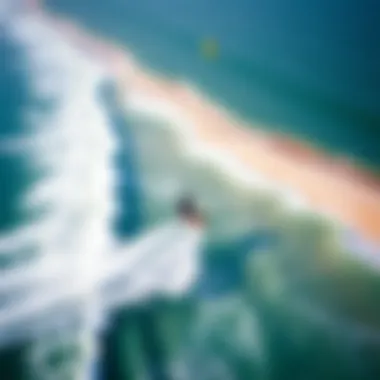
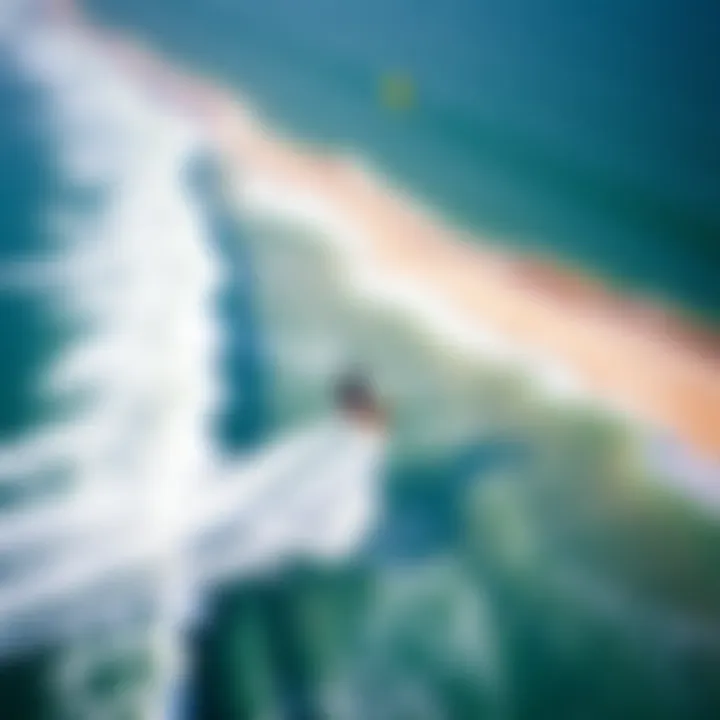
Even when we are out on the water, there are practices we can adopt to diminish our environmental footprint. Here are some key responsible riding practices:
- Avoid shallow waters: Kitesurfing in shallow areas can disturb the seafloor and damage marine life. Always opt for deeper waters to minimize this impact.
- Mind your speed: Fast-paced riding can lead to erosion. Slow down near vulnerable habitats and respect the flora and fauna around you.
- Educate others: Share your knowledge about environmental awareness with fellow kitesurfers. Encourage newbies to understand the importance of conservation and respect for nature.
Involving yourself in organizations that focus on marine conservation can elevate your enthusiasm for the sport. Many such organizations would be glad to have volunteers who are also kitesurfers, thus directly tying your passion to action.
Kitesurfing Gear Maintenance
Kitesurfing, similar to any adventure sport, heavily relies on equipment. Without proper gear, one might face unnecessary risks or compromised performance on the water. Hence, maintaining kitesurfing gear isn’t merely a good habit—it's an essential practice that ensures safety and enhances the overall experience of the sport.
Cleaning and Storage
Taking care of your kitesurfing gear begins with cleaning. After a session, especially in saltwater, rinsing your kite, board, and harness with fresh water can significantly extend their lifespan.
- Kite: Make sure to remove sand or debris. Gently clean it without using any harsh chemicals, as they can degrade the material. A soft brush or cloth works wonders here.
- Board: Just as with your kite, rinse off any salt or sand. Inspect the bottom for scratches or damage. Dry it thoroughly before storing.
- Harness: This gear can get smelly over time. Rinse it often and hang it to dry completely. Avoid leaving it in direct sunlight for extended periods, as UV rays may weaken the fabric.
Proper storage is equally critical. Dependent on climate, you might want to store your gear inside during colder months. Use a bag for protection against dust, moisture, and curious rodents. For instance, rolling your kite rather than folding it can help maintain its shape. Always store equipment in a cool, dry place. This prevents mold growth and preserves the material integrity.
Inspecting Your Equipment
Inspecting your gear should be seen as a ritual before every kitesurfing adventure. Consider it a health checkup for your equipment.
- Kite Lines: Look for frays or knots along the lines. They must have integrity; otherwise, they could snap during use, leading to accidents.
- Kite: Check for tears or punctures in the canopy. Ensure seams are intact. Small tears can often be patched, but significant damage may require professional repair.
- Board: Inspect the fins and pads for any cracks or detachments. A loose fin can reduce performance significantly.
- Harness: Ensure all buckles work and that there are no frayed straps. A faulty harness could lead to unexpected falls or worse.
Adopting a systematic approach to gear inspection tackles many potential problems before they escalate. Remember, prevention is always better than a cure. Regular maintenance should become part of your routine, ensuring you are ready to hit the water whenever the conditions are ripe.
"A stitch in time saves nine." - This old adage rings true for kitesurfing equipment. Taking a few moments to inspect and clean your gear can save you serious headaches out on the water.
For more in-depth information on maintenance and care for kitesurfing gear, visit the following:
- Wikipedia on Kitesurfing
- Britannica's Adventure Sports
- Community forums like Reddit on Kitesurfing can also provide valuable insights and tips.
The Evolution of Kitesurfing Technology
The realm of kitesurfing has evolved tremendously over the last few decades, shaped significantly by advancements in technology. This evolution is not merely about flashy new gadgets; it's about enhancing performance, safety, and the overall experience for riders at all levels. Understanding these changes helps enthusiasts appreciate their gear more and make informed choices that can elevate their time on the water.
Innovations in Kiting Gear
In the world of kitesurfing, the progression in gear design and technology has had a profound impact. Riders today benefit from innovations that were just dreams not too long ago. Here are some of the standout advancements:
- Hybrid Kites: Combining characteristics of traditional kites with designs optimized for specific conditions. They offer better control and versatility.
- Lightweight Materials: Use of durable, lightweight fabrics like ripstop nylon has increased the maneuverability of kites. Lighter gear is especially crucial for enhancing the riding experience while minimizing fatigue during extended sessions.
- Inflatable Boards: These boards provide enhanced floatation and stability, making them perfect for beginners as well as those tackling choppy waters. Their portability is an added bonus for adventurous riders who travel frequently.
Given these innovations, riders can customize their setup to match their skill level and riding style more closely than ever before. Being aware of available technology can make a significant impact on a kitesurfer’s journey.
Impact of Technology on Performance
As technology continues to infiltrate the sport, measuring its impact on performance becomes essential. Here are some notable considerations:
- Improved Aerodynamics: The design of kites has become more aerodynamic, allowing riders to experience better wind efficiency. This means they can ride faster and with less effort.
- Enhanced Control Systems: Modern control systems, often equipped with safety features like quick release mechanisms, aid in stability. This gives riders the confidence to push their limits without the constant worry of unpredictable fallouts.
- Performance Tracking Devices: Devices such as GPS trackers and performance monitors enable riders to track speeds, distances, and other stats, allowing them to analyze their performance. This analysis can lead to better skill development and an overall enhanced experience.
The integration of technology into kitesurfing is like adding a turbocharger to a car; it doesn’t just improve speed but also allows for more enjoyable rides and greater safety.
Embracing these advancements equips riders to adapt to varied conditions with more ease and finesse. As kitesurfing continues to evolve, so does its community, with clubs, forums, and online resources aiding enthusiasts in navigating this dynamic landscape.
For further insight, you can explore resources like Wikipedia, Britannica, or community discussions on Reddit. These platforms can enhance your understanding and help keep you abreast of the latest developments.
Community and Culture in Kitesurfing
Kitesurfing is not just a sport; it embodies a vibrant community and rich culture, creating a profound sense of belonging among its practitioners. The camaraderie found on beaches, in clubs, and during events fosters connections that stretch beyond the water. Recognizing the importance of community in kitesurfing provides insight into the joys and shared experiences that enhance this exhilarating sport.
Building Local Communities
Local communities serve as the backbone of the kitesurfing experience. They offer support and encouragement to newcomers and enthusiasts alike. Here are some factors highlighting the significance of these communities:
- Shared Knowledge: Local kiteboarders often share tips, tricks, and insights that may not be found in textbooks. This wisdom covers everything from choosing the right gear to mastering advanced techniques specific to regional conditions.
- Support Networks: Having a group of fellow riders around creates a support system, especially for beginners. Mentorship plays a key role here, helping novices navigate common challenges they might face on their learning journey.
- Social Interaction: The beach becomes more than just a place to ride; it transforms into a social hub. Friendship forms over shared triumphs and occasional mishaps. Just like the wind, these bonds can take unpredictable paths, but they often lead to lifelong friendships.
- Team Spirit: Engaging in group activities, such as beach clean-ups or charity events, strengthens the community’s spirit. It instills a sense of responsibility towards the environment, allowing participants to make sustainable choices when kitesurfing.
In many areas, you’ll find local clubs which organize meet-ups and collective outings. Joining such groups often enhances one’s experience, making the sport more enjoyable and fulfilling.
Events and Competitions
Events and competitions signify much more than just competitive spirit—they encapsulate the essence of kitesurfing culture. They offer an avenue for riders to showcase their skills, connect with fellow enthusiasts, and experience the thrill of the sport on a grand scale. Here’s what makes these gatherings special:
- Skill Development: Events such as local or international competitions often include workshops and training sessions led by skilled riders and professionals. Whether you’re hoping to refine your freestyle technique or improve your jumping, these opportunities can elevate your skills dramatically.
- Celebrating Diversity: Kitesurfing events draw participants from around the globe. Riders of different backgrounds and cultures come together, creating a melting pot of experiences and styles. This exposure fosters learning and broadens perspectives about the sport.
- Networking Opportunities: Competitions serve as excellent networking platforms for aspiring professional riders. They provide exposure to sponsors, brands, and industry contacts, paving the way for future collaborations or career advancements.
- Community Engagement: Many events prioritize environmental consciousness, linking competitions with beach clean-ups or awareness campaigns. The community often comes together, creating a positive impact beyond just riding the waves.
Without a vibrant community, kitesurfing would lose its essence—the thrill of shared experiences, the bonds formed over waves, and the collective push toward mastering the art of riding.
Engagement in local events can drastically enhance your experience as a kitesurfer. Whether you’re participating in competitions or simply enjoying the communal atmosphere, being part of this culture elevates the sport to new heights.
Each kite, every board, every ride contributes to a larger tapestry of kitesurfing that transcends geographic boundaries and unites all enthusiasts under the same sky and water.
Challenges and Solutions in Kitesurfing
Kitesurfing, while exhilarating, comes with its fair share of challenges that both beginners and seasoned riders face. Understanding these hurdles is crucial not only for safety, but also for enhancing the overall experience on the water. By identifying common issues and providing effective solutions, we can build a stronger foundation for those interested in this thrilling sport.
The realm of kitesurfing is full of unpredictable elements—think shifting winds and changing tides—that can catch anyone off guard. Additionally, psychological barriers such as fear and stress can hinder performance and enjoyment. This section aims to candidly address these difficulties and offer practical recommendations to overcome them.
Overcoming Fear and Anxiety
Fear and anxiety are natural responses, especially for those stepping onto the water for the first time. Many riders grapple with the fear of falling or not being in control of the sport, which can lead to a mental block that stifles improvement. To counteract these feelings:
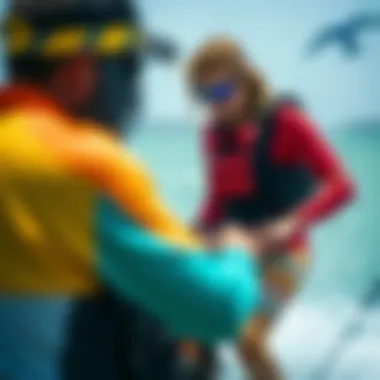
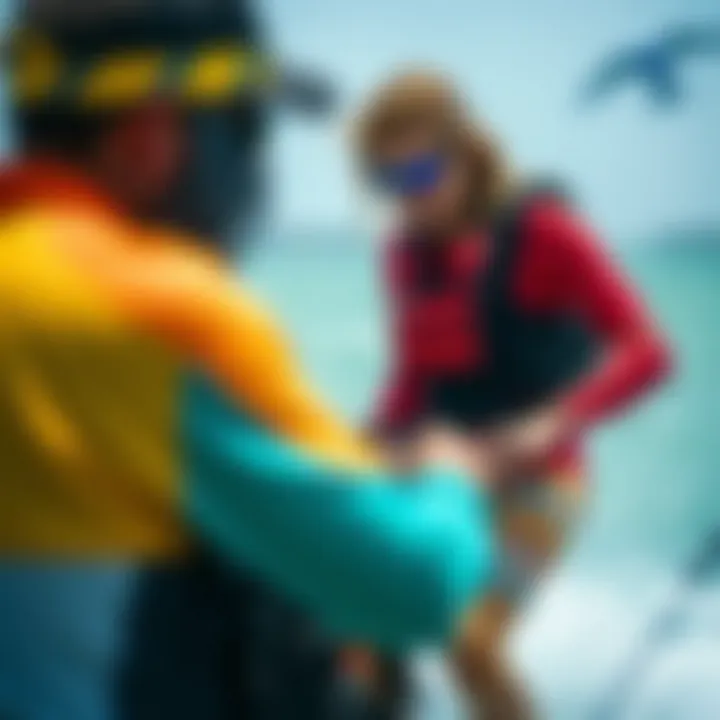
- Take Incremental Steps: It's advisable to start slowly. Begin on a calm day and in shallow water. Familiarize yourself with your equipment and how it interacts with the wind. As confidence grows, gradually tackle more challenging conditions.
- Mindfulness Techniques: Incorporating breathing exercises and visualization can also help. Before hitting the water, take a moment to envision a successful session. Picture yourself riding smoothly and enjoying it.
- Join a Community: Connecting with fellow kitesurfers can ease anxiety. Having a support system provides encouragement and reassurance. Their shared experiences can help demystify common fears.
"Even the mightiest of storms start as gentle breezes. Don't let fear be the wind that keeps you grounded."
Adapting to Changing Conditions
Kitesurfing is heavily reliant on weather and water conditions, which are constantly in flux. Competent riders must learn how to adapt quickly to these changes. Here are some strategies to improve adaptability:
- Stay Informed: Familiarize yourself with local weather patterns, tides, and wind conditions. Apps like Windy or Kite Buddy can offer reliable real-time updates right at your fingertips.
- Practice Versatility: Regularly try kitesurfing in different conditions. This diverse exposure will enhance your ability to respond to varying factors—like unexpected gusts or shifts in tide—more smoothly.
- Gear Awareness: Understand the specifics of your equipment and how they perform under different conditions. For instance, a larger kite might be suitable for light winds, while a smaller kite excels in stronger gales.
Adapting to changing conditions not only contributes to safety but also enhances your overall performance. A rider prepared for anything can make the most out of every session, regardless of Mother Nature's whims.
Tackling the challenges of kitesurfing is part of the journey towards mastery. With the right mindset and strategies in place, riders can triumph over fear and confidently adapt to the ever-changing elements of the sport.
Psychological Aspects of Kitesurfing
The mental facets of kitesurfing can’t be overlooked as they play a pivotal role in both performance and enjoyment of the sport. Kitesurfing demands not only physical agility but also sharp mental engagement. Riders face various emotional obstacles, from overcoming fear to boosting focus. By understanding these psychological aspects, a kitesurfer can truly elevate their performance and overall satisfaction on the water.
Focus and Concentration
Kitesurfing is not just about riding the waves; it’s about staying sharp and aware of your surroundings. A single moment of distraction can lead to mishaps, which is why focus and concentration are the cornerstones of effective kitesurfing. When you're out on the water, your mind should be fully engaged.
Sometimes, it’s easy to feel overwhelmed with all the stimuli around – wind, water, and even fellow riders. Hence, maintaining laser focus is vital.
Some methods to sharpen concentration include:
- Breathing Techniques: Slow, deep breaths can clear your mind, helping you hone in on what you need to do. It’s incredible how something so simple can bring clarity in moments of chaos.
- Pre-Ride Visualization: Before hitting the water, envision the maneuvers you plan to execute. This prepares your mind and sets a direction for your ride, allowing you to be more deliberate in your actions.
- Mindfulness Practices: Adopting mindfulness can assist in keeping distractions at bay. This helps you remain present at the moment, ultimately resulting in a smoother ride.
By fostering a strong focus, you create a mental environment that allows your body to perform optimally, thus enhancing your kitesurfing experience.
Building Confidence on the Water
Confidence is not just a nice-to-have in kitesurfing — it’s essential. When doubts and fears creep in, it can shatter your ability to ride effectively. Building confidence involves experience, proper technique, and mental resilience. It’s a journey that every rider must undertake.
Here are some strategies that can help:
- Set Realistic Goals: Start with attainable objectives. Whether that’s mastering a new trick or improving your balance, knocking them off your list builds confidence.
- Celebrate Small Wins: Every time you achieve something, no matter how minute, take a moment to acknowledge it. Celebrating these wins reinforces a positive mindset and fuels your confidence.
- Seek Support and Guidance: Find a mentor or join a local kitesurfing community. Being around experienced riders can provide tips, encouragement, and camaraderie — all of which bolster your self-assurance.
Improving your confidence on the water can have a ripple effect. As you become more self-assured, you might find it easier to take on challenges and expand your horizons within the sport, making your journey through kitesurfing not just enjoyable, but a source of personal growth as well.
"Confidence is not self-esteem; it's having trust in your ability to perform a given action at a certain moment."
Embracing these psychological aspects ensures that not only does the sport stay thrilling, but it also saves you from unnecessary frustrations. The right mindset can turn a good day on the water into an extraordinary one.
The Future of Kitesurfing
The landscape of kitesurfing is ever-evolving. As technological advancements continue to influence this thrilling sport, it's essential to look ahead and understand what the future holds. Addressing emerging trends and the potential for growth not only excites enthusiasts but also helps to foster a deeper appreciation for what lies ahead.
Emerging Trends
Several trends are beginning to shape the future of kitesurfing. These range from the integration of enhanced materials to more sustainable practices that prioritize environmental protection. Here are a few key developments:
- Eco-friendly Gear: Manufacturers are starting to embrace eco-conscious materials. This not only reduces the environmental impact but also resonates with a community increasingly focused on sustainability. The growth of biodegradable kites and recyclable boards is a key example this shift.
- Smart Technology: Imagine kites that can monitor wind conditions and adjust accordingly. This is no longer the realm of science fiction; smart kites equipped with sensors are making their way into the market. This tech assists riders in optimizing performance and enhancing safety.
- Increased Accessibility: The advent of inflatable kites and lightweight boards has made kitesurfing more accessible to newcomers. More people can join the sport regardless of their physical prowess or previous experience, thus expanding the kitesurfing community.
"Innovation in kitesurfing gear is not just about performance; it's about inclusivity and sustainability."
- Virtual Training Environments: With technological advancements, virtual reality (VR) is becoming a reality for training. Aspiring kitesurfers can practice maneuvers in a simulated environment before hitting the water, allowing for a safer learning experience.
These trends showcase that the future of kitesurfing is not merely about gear improvement but also involves a fundamental shift in how enthusiasts interact with the sport and the environment around them.
Potential for Growth in the Sport
The potential for growth in kitesurfing remains broad and exciting. With a unique blend of thrill and skill, this sport is well-positioned to attract new participants across various demographics. Here are some considerations:
- Global Reach: Kitesurfing is rapidly gaining popularity in areas once considered off the grid. Countries in Africa, Asia, and South America are becoming hotspots for both novice and seasoned riders. This expansion opens opportunities for new communities, training schools, and events.
- Youth Engagement: With the rise of adventure sports, younger generations are looking for more exhilarating activities. Kitesurfing's adrenaline factor can draw them away from traditional sports, further fueling its growth. Initiatives aimed at introducing kitesurfing in schools or clubs can have long-lasting impacts.
- Event Popularity: Competitions and festivals dedicated to kitesurfing are popping up globally. The buzz of these events not only raises awareness but also inspires new riders to join the sport.
- Supportive Infrastructure: As the number of kitesurfers grows, so does the need for infrastructure. Improvements in beaches, schools, and rental services are likely to enhance the accessibility of the sport, catering not only to locals but also to tourists.
Epilogue
In this fast-paced world of kitesurfing, wrapping up the journey with a clear conclusion is crucial. The right takeaways from your adventure can shape not only how you ride but how you view the sport itself. As we have explored in this extensive guide, kitesurfing encompasses far more than just the thrill of gliding on water—it combines elements of skill, artistry, and community.
One of the key elements we've discussed is the importance of understanding equipment choices. Being familiar with the nuances of kites, boards, and harnesses can drastically impact your experience on the water. These decisions often reflect a rider’s personal style and skill level, which emphasizes the individuality found within the sport.
Additionally, safety protocols play a vital role. The consideration for weather conditions and emergency procedures is not only a matter of precaution but also a pathway to confidence. When you know how to navigate challenges, you can fully immerse yourself in the excitement of kitesurfing.
Another significant point raised in our discussions is the enriching aspect of community and culture. Engaging with fellow kitesurfers at local events creates bonds that enrich the overall kitesurfing experience. Whether it’s cheering for competitors or sharing tips on techniques, each interaction fosters a deeper love for the sport.
Lastly, we delved into the future of kitesurfing, where emerging trends and technological advancements promise growth. Staying abreast of these changes keeps the excitement alive, offering new techniques and possibilities to explore.
Taking all these components into account, it’s clear that kitesurfing is not merely a hobby; it’s a multifaceted experience that grows with each rider. Embrace this understanding as you continue your journey in kitesurfing.
Recap of Key Points
In summary, here are some crucial takeaways from our article:
- Equipment Knowledge: Understanding your gear leads to enhanced performance.
- Safety First: Prioritize safety protocols to build confidence.
- Community Engagement: Connect with others to enrich your kitesurfing experience.
- Future Trends: Stay informed about advancements in technology and techniques.
These aspects are interlinked and contribute to mastering the art of kitesurfing.
Encouragement for New Riders
For those new to kitesurfing, remember that the learning process is as beautiful as the sport itself. Don't feel overwhelmed by the information shared—take it step by step. Each rider starts somewhere, and it’s perfectly normal to feel like a fish out of water at first.
Set small goals when you start. Whether it’s successfully launching your kite or catching your first wave, celebrating those little victories will fuel your passion and growth.
Lastly, don’t hesitate to seek mentorship. Learning from experienced instructors can make a world of difference in how fast you progress.
With persistence, patience, and an open heart, you’ll soon find yourself fully immersed in the thrilling world of kitesurfing. Embrace the stumbles, enjoy the rides, and above all, don’t lose sight of the joy that brought you to the water.







